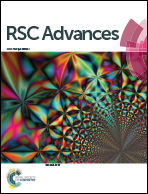Synthesis of novel isophorone-based dyes for dye-sensitized solar cells†
Abstract
Four organic dyes containing isophorone as the π-bridge unit were synthesised and their photophysical and electrochemical properties were characterised. They were then used to fabricate dye-sensitised solar cells. Arylamine derivatives and cyanoacrylic acid functioned as electron donors (D) and electron acceptors (A), respectively, to form a D–π–A system without the need for a Pd catalyst. YC-1, with a long chain hexyloxy group and a strong phenothiazine donor moiety, improved both the open-circuit voltage (Voc) and short-circuit current (Jsc) and reduced charge recombination. The optimum device had a Jsc of 14.86 mA cm−2, a Voc of 0.67 V, a fill factor of 0.62 and a photon-to-current conversion efficiency of 60% at 385–605 nm, corresponding to an overall conversion efficiency of 6.18%. The photophysical properties of the dye-sensitised solar cells were analysed using a time-dependent density functional theory model with the B3LYP functional. The electronic nature of the devices was elucidated using electrochemical impedance spectroscopy and controlled intensity modulated photo spectroscopy.


 Please wait while we load your content...
Please wait while we load your content...